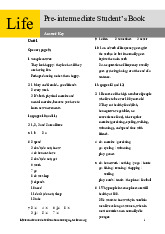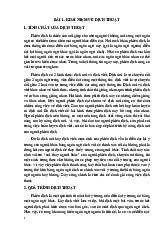




Preview text:
LESSON PLAN
TIẾNG ANH 11 FRIENDS GLOBAL
UNIT 3: SUSTAINABLE HEALTH
LESSON 3B – GRAMMAR: SPECULATING AND PREDICTING I. OBJECTIVES
By the end of this lesson, Ss will be able to: 1. Knowledge
- Use will, may, might, could and the first conditional to make speculations and predictions about the future.
- Have some knowledge about bio-printing. 2. Competences
- Understand an article about bio-printing.
- Make predictions about their future using various structures.
- Develop self-study skills, collaborative skills and creativity. 3. Personal qualities
- Be more aware of their future plans and study.
- Be collaborative and supportive in pair work and teamwork.
- Actively join in class activities. II. MATERIALS
- Grade 11 textbook, Unit 3, Grammar
- Computer connected to the Internet - Projector / TV - PowerPoint Unit 3B III. PROCEDURES
1. Activity 1: WARM-UP (5 mins) a. Objectives:
- Introduce the new lesson and set the scene for Ss to acquire new language.
- Get students' attention at the beginning of the class.
- Students can gain more confidence and interest in the lesson. b. Content: - Video clip - Exercise 1. - Exercise 2. c. Products:
- Students watch and response to the video clip through group discussion d. Organisation
TEACHER’S AND STUDENTS’ ACTIVITIES CONTENT
Video: What are they doing? (2 mins)
- Teacher shows the video and say: “This is the Video in the PowerPoint
technology of the future. Can you guess what might they be doing?”
- After the clip, Ss work in pairs and give answers to
what the people in the video are doing
- T doesn’t show the answer know but lead-in to the Unit 3B and Exercise 1
Exercise 1: Look at the photo and the title of the article. What do you think the article is about? (1 min)
- T focuses Ss’ attention on the photo. Ask students
what they can see. (a heart in someone’s hand)
- Students then look at the title (bio-printing) and
discuss in pairs what the article might be about.
- Elicit a few answers.
Exercise 2: Read the article and check your ideas. (2 mins)
- Students read the article and check their ideas. Answer key
- T can ask some follow-up questions: Did you know
Bio-printing: using 3d printers to print
that 3D printing can print body parts? Are you surprised human organs and body parts.
by this? How do you think 3D printers work?
- A few students volunteer to share their ideas with the class. e. Assessment
- Teacher observes the groups and discussion.
- T gives feedback to group answers and individual answers.
2. ACTIVITY 2: SPECULATING AND PREDICTION (may/might/will) (20 mins) a. Objectives:
- Ss know the forms and when to use will, may, might when making speculations or predictions.
- Ss can make speculations or predictions about their future using may, might, will. b. Content: - Exercise 3 (p.38) - Grammar builder (p. 118) - Exercise 4 (p. 38) c. Products:
- Students complete exercises in the book.
- Ss discuss with their friends. d. Organisation
TEACHER’S AND STUDENTS’ ACTIVITIES CONTENT
PRESENTATION – Exercise 3: Match the highlighted structures in the article with rules a–d in
the Learn this! box below (5 mins)
- T goes through the Learn this! box.
- Students then match the highlighted phrases in the
article with the rules in the box.
- T checks answers as a class. Answers:
a will be able; won’t die
b will probably be; are certain that bio- printing will revolutionise c could save, could play d might not come
PRACTICE – Grammar builder 3.1: Complete the second sentence so that it has the same
meaning as the first. Use the words in brackets. (5 mins)
- T does the first sentence as an example. Answers:
- Ss work in pairs or individually to complete the
2 you’ll definitely pass all your exams. exercise in 2 minutes.
3 I doubt (that) it’ll rain tomorrow.
- T invites some Ss to go up to the board to write their
4 I’m sure (that) you’ll enjoy the film. answers. 5 Ben might come round later.
- Other Ss check the answers on the board and give
6 I may not go to school tomorrow. \ feedback.
7 I think (that) George will know the - T corrects the exercise. answer.
8 We probably won’t go away this summer.
PRODUCTION – Exercise 4/ The Future Teller Activity: Work in pairs. Make predictions about
your partner’s future life using the prompts. Use will / may / might / could and phrases from the
Learn this! Box above. Your partner says if he / she agrees or not (10 mins)
The Future Teller / Exercise 4:
1. What / study at university? - Ss work in pairs. 2. When / leave home?
- Each student writes on a piece of paper some 3. What job / do?
predictions about their partner’s future by answering the 4. When / get married?
questions in exercise 4 and don’t let their partner see. 5. How many children / have?
- Ss take turns ask and answer. The one that has more
6. What type of car / drive?
correct predictions wins the game.
- T monitors and helps Ss with the language if necessary. e. Assessment
- Teacher checks students’ performance and gives feedback.
3. ACTIVITY 3: THE FIRST CONDITIONAL (20 mins) a. Objectives:
- Ss know the forms and use of the first conditional.
- Ss can use the first conditional make predictions about their future b. Content: - Exercise 5. (p.38)
- Grammar builder 3.2 (p.118-119) - Exercise 6. (p.38) - Exercise 7. (p.38) c. Products:
- Students complete exercises in their books correctly.
- Ss discuss with their friends. d. Organisation
TEACHER’S AND STUDENTS’ ACTIVITIES CONTENT
PRESENTATION – Exercise 5: Study the examples in the Learn this! box below and complete
the rules with the correct verbs and tenses. (5 mins)
- T asks students to read the Learn this! box and Answers: complete the rules.
- T checks answers as a class.
- T asks students what we use the first conditional
for. (to talk about probable future events)
PRACTICE – Grammar builder 3.2: Complete the first conditional sentences. Use the verbs in the brackets. (5 mins)
- Ss work in pairs or individually to complete the Answer key: exercise in 2 minutes.
1 don’t phone; will be 2 tell; will you promise
- T invites some Ss to go up to the board to write 3 will have; doesn’t rain 4 won’t buy; lose their answers.
5 will you do; feel 6 give; will be able to
- Other Ss check the answers on the board and give 7 will make; sends 8 don’t shout; won’t get feedback. - T corrects the exercise.
PRACTICE – Exercise 6: Complete the article below with the correct form of the verbs in
brackets. Use the first conditional. In gaps 4 and 6, use a modal verb to make the prediction less certain. (5 mins)
- T goes through the instructions. Answer key:
- Students read the article and complete it. With a 1 could / can
weaker class, remind students of the tenses in the if 2 will be
and main clause of a first conditional sentence. 3 start
- T checks answers as a class.
4 will / may / might / could become
- T makes sure students understand that for 5 learn
questions 4 and 6, they must use a modal verb with 6 may / might / could be the verb in brackets.
PRODUCTION – Exercise 7/Mingle: Work in pairs. Ask and answer using the first conditional and the ideas below. (5 mins)
- T goes through the instructions and ideas.
1 You feel ill tomorrow morning.
- Students look at the example question and answer 2 The weather is fine at the weekend.
and tell them to start their questions in the same 3 You get poor marks in your next English test. way.
4 Your best friend forgets your birthday.
- Students spend a minute to answer the questions 5 Your own ideas by themselves. Example:
- Mingle: Ss walk around and ask the friends not Q: What will you do if…?
sitting close to them the “What will you do if…?” A: I will visit the doctor questions in exercise 7.
- At the end of the activity, Ss report to the class the answers they have collected. e. Assessment
- Teacher observation on Ss’ performance.
- Teacher’s feedback and peers’ feedback. 4. CONSOLIDATION (2 mins) a. Wrap-up
- If T is using the Classroom Presentation Tool, first do the lesson closer to review what has been covered in this lesson.
- T asks students: What have you learned today? What can you do now? and elicit answers: I
can speculate about the future using ‘may’, ‘might’ and ‘could’. I can make predictions about
the future using the first conditional. I can make first conditional sentences less certain by
using ‘may’, ‘might’ and ‘could’ in the main clause b. Homework
- Prepare for the next lesson




